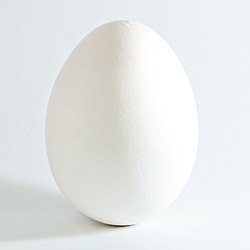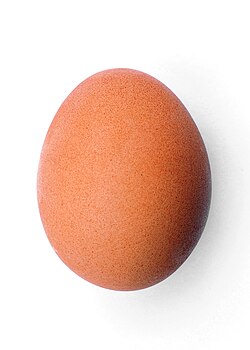Eggshell
This article needs additional citations for verification. (February 2008) |


An eggshell is the outer covering of a hard-shelled egg and of some forms of eggs with soft outer coats.
The generalized eggshell structure, which varies widely among species, is a protein matrix lined with mineral crystals, usually of a calcium compound such as calcium carbonate. It is calcium build-up and is not made of cells. Harder eggs are more mineralized than softer eggs.
Diversity

Insect eggs
Insects and other arthropods lay a variety of styles and shapes of eggs. Some have gelatinous or skin-like coverings, others have hard eggshells. Softer shells are mostly protein. It may be fibrous or quite liquid. Some arthropod eggs do not actually have shells, rather, their outer covering is actually the outermost extraembryonic membrane, the chorion, which serves to protect inner layers. The chorion itself can be a complex structure, and it may have different layers within it. It may have an outermost layer called an exochorion. Eggs which must survive in dry conditions usually have hard eggshells, made mostly of dehydrated or mineralized proteins with pore systems to allow respiration. Arthropod eggs can have extensive ornamentation on their outer surfaces.
Fish, amphibian and reptile eggs
Fish and amphibians generally lay eggs which are surrounded by the extraembryonic membranes but do not develop a shell, hard or soft, around these membranes. Some fish and amphibian eggs have thick, leathery coats, especially if they must withstand physical force or desiccation.
While many reptiles lay eggs with flexible, calcified, eggshells, there are some that lay hard eggs. Eggs laid by snakes generally have leathery shells which often adhere to one another. Depending on the species, turtles and tortoises lay hard or soft eggs. Several species lay eggs which are nearly indistinguishable from bird eggs. Hatching reptiles, like most birds, have egg-teeth with which they slit or peck an opening into the shell to help them emerge.
Bird eggs
Birds are known for their hard-shelled eggs. The eggshell is approximately 95% calcium carbonate crystals, which are stabilized by a protein matrix.[1] Without the protein, the crystal structure would be too brittle to keep its form. The standard bird eggshell is a porous structure, covered on its outer surface with a cuticle (called the bloom if it is around a chicken egg), which helps the egg retain its water and keep out bacteria. As an egg develops within a bird's reproductive system, the shell is laid down as a liquid mineral layer around the already-formed extraembryonic membranes. This takes place in a part of the bird's oviduct which is called the uterus and serves a very different purpose from the uterus of a mammal. The shell is laid down by shell glands. In an average laying hen, the process of shell formation takes around 20 hours. Pigmentation is added to the shell by papillae lining the oviduct, coloring it any of a variety of colors and patterns depending on species. Since eggs are usually laid blunt end first, that end is subjected to most pressure during its passage and consequently shows the most color. The waxy cuticle is deposited on the shell in the bird's oviduct. The chick has an egg-tooth which it uses to start a hole in the hard eggshell to allow it to hatch.
Mammal eggs
Monotremes, egg-laying mammals, lay soft-shelled eggs similar to those of reptiles. The shell is deposited on the egg in layers within the uterus. The egg can take up fluids and grow in size during this process, and the final, most rigid layer is not added until the egg is full-size.
References
See also
- Eggshell skull rule, in tort law
- walk on eggshells, an idiom in the English language
- Kilner, R. M. (2006). "The evolution of egg colour and patterning in birds". Biological Reviews. 81: 383–406. doi:10.1017/S1464793106007044.
